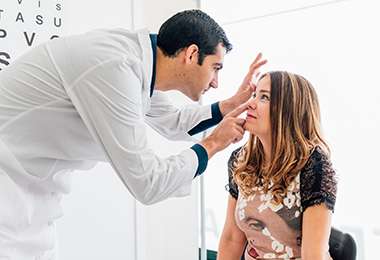
Blepharitis is when there are bacteria and oily flakes at the base of the eyelashes. It causes the eyelids to be red, swollen, and feel like they are burning. Blepharitis is very common, especially with people who have oily skin, dandruff, or dry eyes.
Blepharitis is caused by having extra bacteria at the base of the eyelash than what is normal, which can cause dandruff-like flakes to form. Some people also have issues with oil glands in their eyelids which can lead to Blepharitis.
There are different ways that Blepharitis can be treated, depending on the severity of the symptoms. One way is to use a warm compress over the eye for several minutes. Other ways are to use an eyelid scrub, an antibiotic ointment on the base of the eyelashes, artificial tears, or steroid eye drops to help reduce the redness, swelling, and dry eye.
A Stye, also called a hordeolum, is a small, red, painful bump that grows at the base of the eyelash underneath the eyelid that is usually caused by a bacterial infection. There are two types of Styes: External hordeolum, which is a stye that begins at the base of the eyelash, mostly caused by an infection in the hair follicle, and an Internal Hordeolum, which is a stye on the inside of the eyelid, mostly caused by an infection in an oil producing gland in the eyelid.
A Chalazion is a swollen bump on the eyelid that occurs when the eyelid’s oil glands get clogged. A Chalazion can start as an internal hordeolum.
The difference between a Chalazion and a Stye is that a stye will be very painful, usually caused by an infected eyelash root, often swelling and sometimes affecting the entire eyelid. A Chalazion is not usually painful and develops farther back on the eyelid than a stye. A Chalazion is usually caused by a clogged oil gland and rarely makes the entire eyelid swell.
There are different ways that a Stye and a Chalazion can be treated. A few of those ways are the following: a warm compress, antibiotics, steroid shots, or even surgery to drain the area.
Dermatochalasis is when the skin on the upper or lower eyelid stretches as you get older. This is caused by the loss of the elasticity in the tissue that supports the eyelid.
Once the Dermatochalasis is severe enough that it is blocking your vision, surgery may be considered for treatment. To learn more about blepharoplasty, please click here.
Ectropion is when the eyelid turns outward and moves away from the eye. Many things can factor into causing Ectropion, such as: weak eyelid muscles, a genetic disorder, eyelid growths, any condition causing facial paralysis, or even previous eyelid injuries or surgeries.
A mild case of Ectropion can generally be treated with artificial tears. More severe cases of Ectropion require eyelid surgery, where a piece of the eyelid on the outer edge is removed allowing the muscles and tendons to tighten, repairing the droopy eyelid.
Entropion is when the eyelid turns inward, causing the eyelashes to rub against the eye. Entropion can have different causes such as: eye inflammation, eye infection, a birth defect, previous surgery or injury, or even scarring.
Treatment for Entropion would include eyelid surgery similar to the surgery for Ectropion, where a piece of the eyelid on the outer edge is removed and the muscles and tendons tighten to correct the droopy eyelid.
Ptosis is when, usually, the upper eyelid droops over the eye due to the levator muscle stretches or even separates from the eyelid, which can be caused by aging or an eye injury.
Ptosis is generally treated with surgery.
Trichiasis is when the eyelashes grow inwards towards the eye, rubbing against the cornea and the conjunctiva, irritating the eye.
Some causes of Trichiasis are the following: an eye infection, swelling of the eyelid, autoimmune conditions, or trauma.
There are multiple treatment options for Trichiasis. If your case is mild, your ophthalmologist may just remove the eyelashes with a pair of tweezers, though they have the risk of growing back in the wrong direction. Other treatment options are the following: Ablasion Surgery – uses lasers or radiofrequencies to remove the lashes and the hair follicles, Electrolysis – uses electricity to remove the hair permanently, or Cryosurgery – removes the lashes by freezing them off.
If you feel like you have any of the following eyelid conditions, please call out office today at (864) 583-5312 to set up an appointment.
I was very fortunate to have Dr. Haggerty as my doctor. He found a problem with my eyes that a previous doctor had missed, that could have led to blindness. He fixed the problem painlessly and now my eyes are great. He also did an eyelift for me and I can see so much better than before. For me they are the best!!